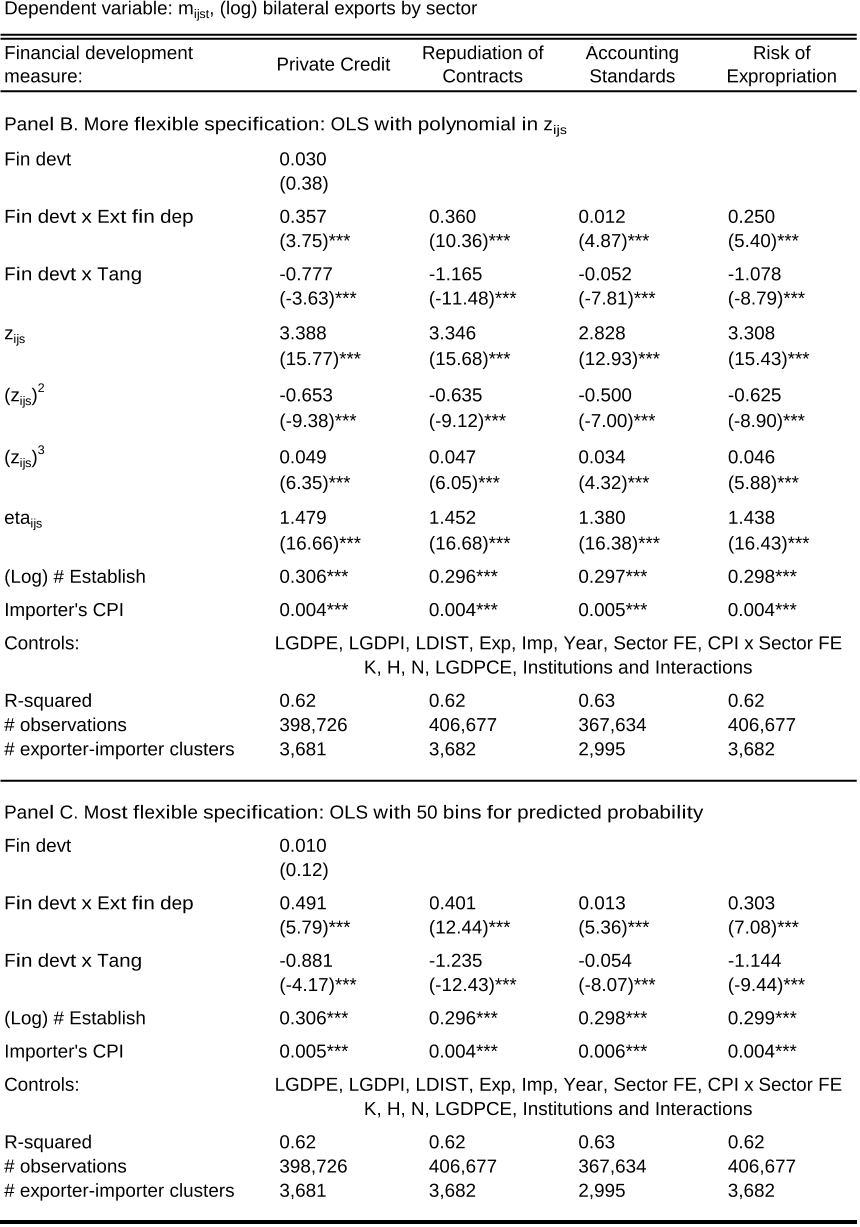Credit Constraints, Heterogeneous Firms and International Trade
Reads0
Chats0
TLDR
This article examined the detrimental consequences of financial market imperfections for international trade and developed a heterogeneous-firm model with countries at different levels of financial development and sectors of varying financial vulnerability.Abstract:
This paper examines the detrimental consequences of financial market imperfections for international trade. I develop a heterogeneous-firm model with countries at different levels of financial development and sectors of varying financial vulnerability. Applying this model to aggregate trade data, I study the mechanisms through which credit constraints operate. First, financial development increases countries' exports above and beyond its impact on overall production. Firm selection into exporting accounts for a third of the trade-specific effect, while two thirds are due to reductions in firm-level exports. Second, financially advanced economies export a wider range of products and their exports experience less product turnover. Finally, while all countries service large destinations, exporters with superior financial institutions have more trading partners and also enter smaller markets. All of these effects are magnified in financially vulnerable sectors. These results have important policy implications for less developed economies that rely on exports for economic growth but suffer from poor financial contractibility.read more
Figures

Table 10. Economic Significance: Predicted vs. Actual Trade Growth 
Table 9. Economic Significance: Comparative Statics 
Table 5. Financial Development and Firm-Level Exports 
Figure 3. The Productivity Cut-off for Exporting 
Table 5. Financial Development and Firm-Level Exports 
Table 1. Export Patterns in the Data
Citations
More filters
Journal ArticleDOI
Enhancing the Ease of Doing Business in APEC Countries: A Comprehensive Review of Literature
TL;DR: In 2015, the Philippines ranked 95th in the World Bank's Doing Business Report as mentioned in this paper, a 13-place improvement from its 2014 rank and a 38-notch jump from 2013.
Posted Content
Financial Reliability and Firms' Export Activity
TL;DR: The authors assesses the importance of firms' financial resources that are necessary to overcome sunk entry costs associated with export and find evidence that the liquidity is mainly used for investments in the development of new products for foreign markets.
BookDOI
Estimating and Calibrating MFMod : A Panel Data Approach to Identifying the Parameters of Data Poor Countries in the World Bank's Structural Macro Model
Andrew Burns,Charl Jooste +1 more
TL;DR: The authors summarizes the World Bank's approach to identifying parameters for key equations in its macro structural model for countries where short sample sizes or major structural changes render traditional time-series approaches infeasible or yield unstable estimates.
Journal ArticleDOI
Entrepreneur income inequality, aggregate saving and the gains from trade
TL;DR: This paper developed a dynamic model of trade with incomplete markets and found that an increase in trade openness increases the share of total profits received by exporters, and thus increases the aggregate supply of capital in the economy.
Journal ArticleDOI
Institutions and Firm’s Participation in the Global Production Network (GPN): Firm-Level Analysis in Indonesia
TL;DR: In this paper, the effect of access to credit, import license, and competition from the informal sector on a firm's participation in the Global Production Network (GPN) is analyzed.
References
More filters
Posted Content
Law and Finance
Rafael La Porta,Rafael La Porta,Florencio Lopez de Silanes,Florencio Lopez de Silanes,Andrei Shleifer,Andrei Shleifer,Robert W. Vishny,Robert W. Vishny +7 more
TL;DR: This paper examined legal rules covering protection of corporate shareholders and creditors, the origin of these rules, and the quality of their enforcement in 49 countries and found that common law countries generally have the best, and French civil law countries the worst, legal protections of investors.
Journal ArticleDOI
Law and Finance
TL;DR: In this article, the authors examined legal rules covering protection of corporate shareholders and creditors, the origin of these rules, and the quality of their enforcement in 49 countries and found that common-law countries generally have the strongest, and French civil law countries the weakest, legal protections of investors, with German- and Scandinavian-civil law countries located in the middle.
Journal ArticleDOI
The Impact of Trade on Intra-Industry Reallocations and Aggregate Industry Productivity
TL;DR: This paper developed a dynamic industry model with heterogeneous firms to analyze the intra-industry effects of international trade and showed how the exposure to trade will induce only the more productive firms to enter the export market (while some less productive firms continue to produce only for the domestic market).
Journal ArticleDOI
Finance and Growth: Schumpeter Might Be Right
TL;DR: In this paper, the authors examined a cross-section of about 80 countries for the period 1960-89 and found that various measures of financial development are strongly associated with both current and later rates of economic growth.
ReportDOI
Financial Dependence and Growth
Raghuram G. Rajan,Raghuram G. Rajan,Raghuram G. Rajan,Luigi Zingales,Luigi Zingales,Luigi Zingales +5 more
TL;DR: This paper examined whether financial development facilitates economic growth by scrutinizing one rationale for such a relationship; that financial development reduces the costs of external finance to firms, and found that industrial sectors that are relatively more in need of foreign finance develop disproportionately faster in countries with more developed financial markets.